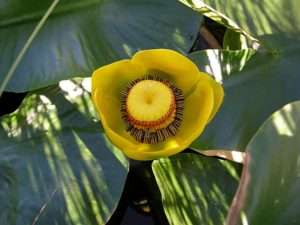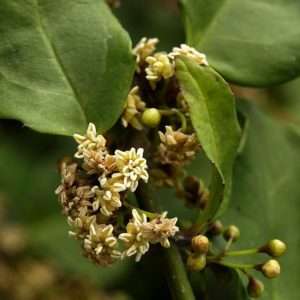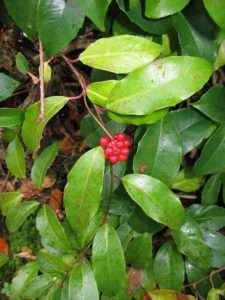
One of the nice things about living on a lake is that I can go kayaking whenever I feel like it–or, more realistically, when I have the time to do so. I hope someday to be the kind of person who can start every day with a serene glide across the water, but for now I take my opportunities as I’m able to. One of my favorite things about the experience is getting to start and end my journey by paddling through a huge patch of western yellow pond lily (Nuphar polysepala, previously categorized as a subspecies of Nuphar lutea). And it was this plant that was my introduction to the concept of basal angiosperms.
See, when I have a species I really like, I spend time researching it. So I decided to dig into the natural history of this plant, one of eight extant species in the genus. In addition to finding out that the seeds are edible, and the roots are a traditional medicine, I also learned that they are an example of basal angiosperms–something that piqued my interest in tracing the evolution of various beings.
What are Basal Angiosperms?
Basal angiosperms are essentially the oldest orders of flowering plants. Prior to the first angiosperms, plants either reproduced with cones like today’s conifers and other gymnosperms, or through spores and gemmae as with bryophytes (which may also reproduce through fragmentation.) Flowers were a new mutation that used visually appealing structures and scents to attract animals as vehicles for spreading pollen to other members of the same plant species. Flower-producing plants–the angiosperms–have since exploded into countless species, with about 300,000 known species in existence today. The most ancient lineages are known as ANITA grade.
ANITA is short for a group of five orders: Amborellales, Nymphaeales, Illiciales, Trimeniaceae, and Austrobaileya. More recently Illiciales and Trimeniaceae have been folded into Austrobaileya, leaving the acronym shorter at ANA, though some recent papers persist in using ANITA.

Angiosperms are commonly thought to have evolved during the early Cretaceous Epoch, around 135 million years ago, though pollen that may be angiosperm in origin was found dating back to about 250 million years ago. Soon after angiosperms appeared, their lineage began to branch out. The earliest branches to diverge were the basal angiosperms. Amborella trichopoda is the sole representative of the oldest branch; all other flowering plants share the same common ancestor from which Amborella‘s ancestors diverged.
Amborella lives all the way on the other side of the planet from me, on the island of Grand Terre in New Caledonia, which means my chances of getting to see it in person are pretty slim. However, there are lots of basal angiosperms out there, and they have some pretty interesting qualities.
Older than the Monocots and Eudicots
If you learned about plants in middle school or junior high, you very likely learned about “monocots and dicots” as being the two main divisions of flowering plants. In truth, these two are joined by the basal angiosperms, and a fourth group, the Magnoliids. These latter Magnoliidae are the next-oldest group of angiosperms, and they and the basal angiosperms both pre-date the emergence of the monocots and dicots (now known as eudicots). Species in these older lineages have physical traits of both the monocots and dicots, giving a glimpse of what flowers were like before these more numerous groups appeared. This also shows that monocots and eudicots have a common ancestry, rather than one evolving from the other.
The Nymphaeales, of which my beloved western pond lilies is a part, are a good example. If you examine the structure of a stem of a pond lily, it looks very much like that of a eudicot. Rather than having vascular tissue distributed throughout the the stem’s tissue as with a monocot, the vascular bundles are arranged in a circle like in a dicot. But the stem lacks the eudicots’ cambium, which creates xylem and phloem.
Like the monocots, Nymphaeales flower parts are arranged in multiples of three, whether petals, stamens, etc. However, this does not mean the basal angiosperms are the direct ancestors of monocots. Compare Amborella which has varying numbers of tepals (the forerunner of sepals and petals), stamens, carpals and other parts depending on whether the flower is male or female. Neither sex of Amborella displays a trimerous (parts in multiples of three) flower. And, just for the record, eudicot flower parts generally show up in multiples of four or five.
The relationships among these various groups of flowering plants aren’t just dependent on the physical characteristics, though. A lot of what we’ve been learning lately about basal angiosperms comes through genetic research. For example, a recent debate concerns whether Amborella is the oldest basal angiosperm, or whether Amborella and the Nymphaeales together are the very oldest lineages, closer related to each other than the rest of the angiosperms.
Your Friendly Neighborhood Basal Angiosperms

If you live in Australia, east Asia, or the Caribbean, you have species from the Austrobaileya in your region. Austrobaileya scandens is the only member of its genus and family, and is located in northeast Queensland. The Schisandraceae and Illiceaceae are woody plants found in tropical areas in east Asia and the Caribbean. While in tropical Southeast Asia, you might look for the Trimeniaceae, various species which may also be found in eastern Australia and the Pacific Islands. Amborella, of course, is limited to New Caledonia.
The Nymphaeales includes the better part of a hundred species, including the various water lilies, fanworts, and similar plants. They are quite widespread, found commonly (to include as invasive species in some cases) on all continents except for Antarctica.
As for me, I will continue to enjoy the presence of my local western yellow pond lilies. Now that I have a deeper understanding of their evolutionary history, I can better appreciate what unique neighbors they are!

Thank you so much for clarifying the basal angiosperms. It has helped me to better understand their position in relation to other angiosperms. Do you have timeline which
Indicates overlapping evolution among the gymnosperms and bryophytes, etc. ?
Thanks again
Pat Ebrom
I’m glad you enjoyed this article! With regards to bryophytes and gymnosperms, bryophytes appeared much earlier, and the liverworts, mosses, and hornworts are all considered to be a monophyletic group–in short, they’re all more closely related to each other than the vascular plants. The earliest vascular plants, which first evolved about 425 million years ago, were likely clubmosses, horsetails, and ferns, which like the bryophytes have spores rather than true seeds. A proto-seed structure has been found in Runcaria heinzelinii, which lived about 385 million years ago; it lacks the hard covering of a seed, but has some similar internal features. It wasn’t until the gymnosperms appeared about 360-350 million years ago that we have solid evidence of proper seeds.
So, in short, by the time the gymnosperms appeared, the bryophytes had already been established for tens of millions of years.